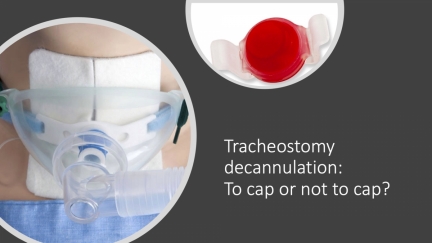Tracheostomy decannulation: To cap or not to cap?

A 49-year-old woman was intubated for acute hypoxemic respiratory failure secondary to pneumonia, which was complicated by empyema. She failed extubation and ultimately required tracheostomy for prolonged mechanical ventilation. After transfer to the intermediate care unit, she was successfully weaned from the ventilator for over 24 hours. She tolerated prolonged deflation of her tracheostomy cuff and swallowed water without aspiration. She underwent a tracheostomy tube occlusion test and there was no obstruction to air flow with a size 7 fenestrated tracheostomy tube in place. She is requiring suctioning once every 12 hours. You are assessing her readiness for tracheostomy decannulation and are considering the utility of a capping trial.
The most common reason for tracheostomy placement in the intensive care unit (ICU) is for provision of prolonged mechanical ventilation, typically defined as the need for mechanical ventilation for greater than two weeks. Approximately one out of six critically ill patients requiring mechanical ventilation in the ICU will undergo tracheostomy tube placement. After weaning from mechanical ventilation, the next step for many patients in recovery is moving toward tracheostomy decannulation. What are the markers for decannulation readiness? Is a capping trial necessary? A recent randomized controlled trial published in the New England Journal of Medicine addressed this question.
The authors enrolled adult critically ill patients in five intensive care units in Spain that did not have a contraindication to decannulation, specified as unconsciousness, airway occlusion, severe dysphagia or neuromuscular weakness. All patients had similar 7-mm size fenestrated tracheostomy tubes (TRACOE), unless the BMI was greater than 45. Patients randomized to the control group (n=161) underwent a 24-hour capping trial once they required suctioning no more than every 4 hours. The capping trial was considered failed if decapping was required at any point during the 24-hour trial. Patients randomized to the intervention group (n = 169) were decannulated once they required suction aspiration no more than twice in 8 hours. No capping trials were performed in the intervention group. Patients in both groups received high flow oxygen through the tracheostomy tube until decannulation, unless the tube was capped during a trial, which occurred in the control group only. The primary outcome was time to decannulation after successful weaning from mechanical ventilation. The authors observed that the time to decannulation was shorter in the intervention group (6 days) versus the control group (13 days). Additionally, decannulation failure was more frequent in the control group than the intervention group (5.6% in the control group versus 2.4% in the interventional group). Interestingly, the incidence of pneumonia and tracheobronchitis was higher in the control group, although the difference was not significant.
The results of this study suggest that 24-hour capping trials delay tracheostomy decannulation in conscious critically ill adults as compared to decannulation based on suction frequency alone. Almost three quarters of patients in the control group had at least one failed capping trial, yet 12 patients with repeated failure of capping trials still underwent successful decannulation off protocol. Patients in the intervention group did receive more continuous high-flow oxygen therapy, which provides a small amount of positive airway pressure that could have contributed to successful decannulation. Patients in the intervention group had a lower incidence of respiratory infection. While not statistically significant, the authors suggest the difference may be due to a shorter time with an artificial airway in place or greater use of continuous high-flow oxygen.
Returning to our patient, an alternative approach to a capping trial would be to assess her suction requirements and proceed with decannulation once aspiration was not required more than twice in 8 hours. Similar to the trial participants, she is alert without dysphagia or neuromuscular weakness. Therefore, based on the REDECAP trial by Hernandez et al., she would be a candidate for tracheostomy decannulation given her infrequent need for suctioning (once every 12 hours). Tracheostomy decannulation is a momentous occasion in the recovery from critical illness necessitating prolonged mechanical ventilation and the REDECAP trial provides evidence for the safety of omitting a capping trial and assessing readiness for tracheostomy decannulation based on suction frequency.
References
Hernandez MG et al. High-flow oxygen with capping or suctioning for tracheostomy decannulation. New England J Med 2020;383(11):1009-1017.
